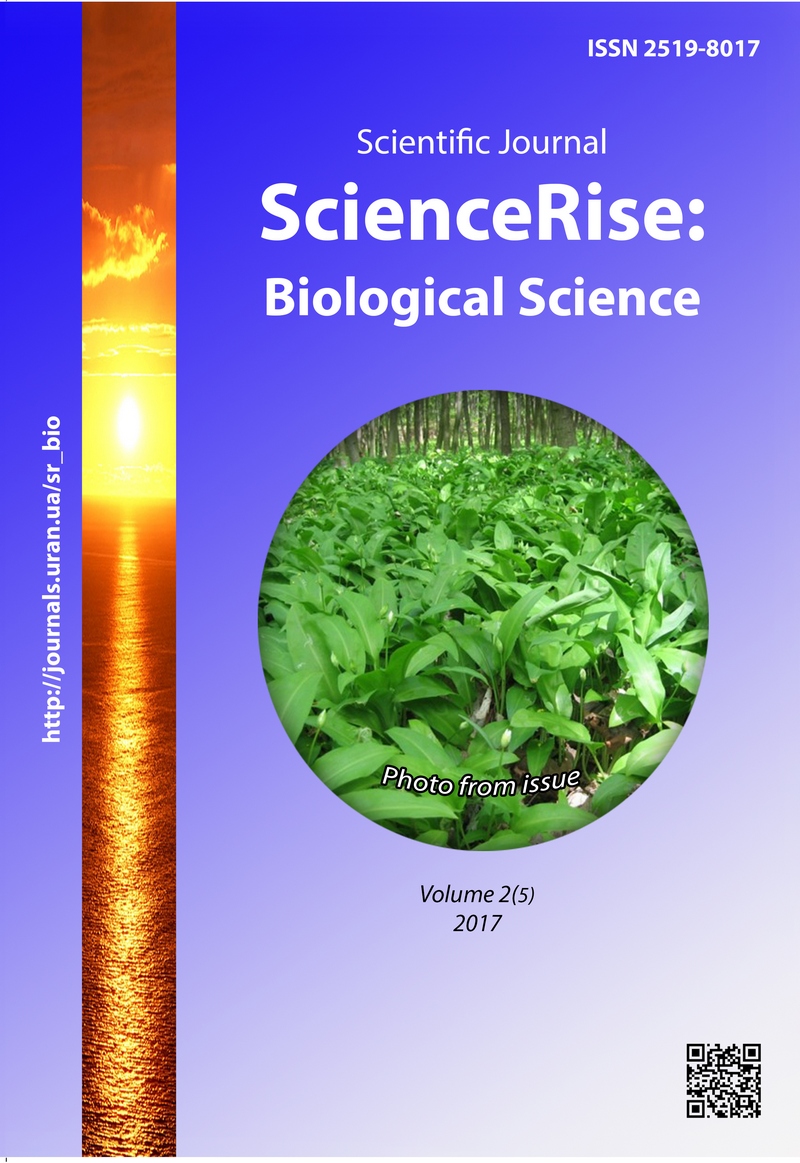Research the effectiveness micro-1 biopreparation against the spring barley diseases under polissya conditions
DOI:
https://doi.org/10.15587/2519-8025.2017.99839Keywords:
spring barley, biopreparation, fungicide, disease, effectivenessAbstract
The antagonistic activity of strain B. amyloliquefaciens subsp. plantarum IMB B-7404 (Micro-1) with the titer of 1-3x107 СFU/ml in relation to the spring barley leaf spot and root rot has been studied in the field and laboratory conditions. It has been found that the treatment of seeds with biopreparation Micro-1 reduces the development of the ordinary root rot by 51,3 %.
It has been determined that a single spraying of crops with the biopreparation during the tillering phase reduces the development of barley Helminthosporium by 42,5 % and double application during the phase of tillering and earing – by 55,0 % respectively.
A single spraying of spring barley with preparation Micro-1 with the titer of 1-3x107 CFU/ml during the tillering phase provides the technical effectiveness against Helminthosporium at 43,8 % and double application during the tillering and earing phase – at 46,8 % respectively.
The application of biopreparation Micro-1on plantings increases the yield of spring barley grain by 0,35–0,45 t/ha as compared to the control
References
- Chaika, O. V., Sheremet, Yu. V., Chaika, T. V., Kapraluk, N. P. (2015). The effeiciency of the integrated treatment of winter barley crops for fighting diseases. Herald of ZNAEU, 1 (2), 120–127.
- Timoshchuk, T. N., Derecha, O. A., Dazhuk, M. A. (2004). Efficiency of winter wheat seeding system of protection against harmful organisms under conditions of Ukrainian Polissya. Herald of SDAU, 1 (8), 152–155.
- Buga, S., Iliuk, А. (2008). Вiological substantiation of winter wheat protection tactics against the diseases. Zemdirbyste-Agriculture, 95 (3), 36–42.
- Dragovoz, I. V., Korzh, Yu. V., Leonova, N. O., Iliash, V. M., Аvdeeva, L. V. (2015). Influence of Bacillus amyloliquefaciens subsp. plantarum IMV B-7404 strain exometabolites on phenylalanine amm onia-lyase activity in winter wheat seedlings. The Ukrainian Biochemical Journal, 87 (6), 136–142. doi: 10.15407/ubj87.06.136
- Khare, E., Maheshwari, D. K., Naveen, K. A. (2011). Suppression of charcoal rot of chickpea by fluorescent Pseudomonas under saline stress condition. Current Microbiology, 62 (5), 1548–1553. doi: 10.1007/s00284-011-9895-3
- Domoradzki, M., Korpal, W. (2008). Otoczkowanie nasion buraka cwiktowego preparatem Chitosan i zarodnikami grzybow Trichoderma viride i Phytium oligandrum. Chemik, 61 (9), 459–460.
- Sivan, A., Chet, I. (1993). Integrated control of Fusarium grown and root not of tomato with Trichoderma harzianum. Crop Protection, 12 (5), 380–386. doi: 10.1016/0261-2194(93)90082-t
- Sultan, M. (2008). Investigations on the efficacy of Bacillus spp. strains on suppression of tomato diseases. Deutsche Pflanzenschutztagung. Kiel, 417, 432.
- Urrea, R., Cabezas, L., Sierra, R., Cardenas, M., Restrepo, S., Jimenez, P. (2011). Selection of antagonistic bacteria isolated from the Physalis peruviana rhizosphere against Fusarium oxysporum. Journal of Applied Microbiology, 111 (3), 707–716. doi: 10.1111/j.1365-2672.2011.05092.x
- Peng, G., McGregor, L., Lahlali, R., Gossen, B. D., Hwang, S. F., Adhikari, K. K. et. al. (2011). Potential biological control of clubroot on canola and crucifer vegetable crops. Plant Pathology, 60 (3), 566–574. doi: 10.1111/j.1365-3059.2010.02400.x
- Niazi, A., Manzoor, Sh., Bejai, S., Meijer, J., Bongcam-Rudloff, E. (2014). Complete genome sequence of a plant associated bacterium Bacillus amyloliquefaciens subsp. plantarum UCMB5033. Standards in Genomic Sciences, 9 (3), 718–725. doi: 10.4056/sigs.4758653
- Tribel, S. O., Sigaryova, D. D., Sekun, M. P. (2001). Methods of testing and use of pesticides. Kyiv: Svit, 447.
- Gritsyuk, N. V. (2013). Effect of complex preparations for pre-processing of seeds to Root rot and infestation of efficiency of winter wheat. Protection and Plant Quarantine, 59, 63–71.
Downloads
Published
How to Cite
Issue
Section
License
Copyright (c) 2017 Alexander Chaika, Svetlana Lapa, Tatiana Tymoshchuk, Natalia Gritsyuk

This work is licensed under a Creative Commons Attribution 4.0 International License.
Our journal abides by the Creative Commons CC BY copyright rights and permissions for open access journals.
Authors, who are published in this journal, agree to the following conditions:
1. The authors reserve the right to authorship of the work and pass the first publication right of this work to the journal under the terms of a Creative Commons CC BY, which allows others to freely distribute the published research with the obligatory reference to the authors of the original work and the first publication of the work in this journal.
2. The authors have the right to conclude separate supplement agreements that relate to non-exclusive work distribution in the form in which it has been published by the journal (for example, to upload the work to the online storage of the journal or publish it as part of a monograph), provided that the reference to the first publication of the work in this journal is included.









